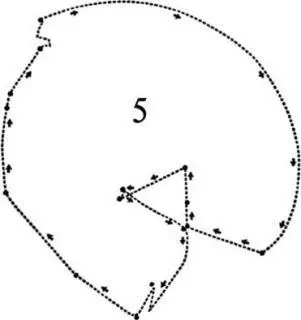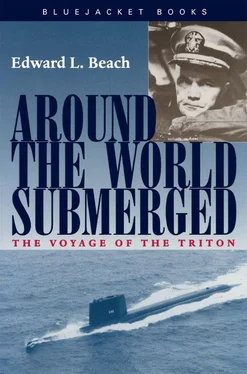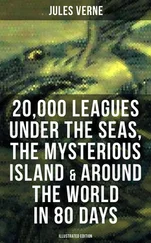The second design Tom turned out was a beauty. Twenty-three inches in diameter, it depicted a globe in relief, upon which a wreath of olive branches was superimposed. Forming the bottom of the wreath was the US Submarine Force twin-dolphin insignia, and in its center a representation of Magellan’s flagship, the 120-ton Trinidad. Beneath the ship we placed the dates 1519-1960, representing the dates of Magellan’s trip and our own, and inside the circumference of the globe the Latin motto, “Ave Nobilis Dux Iterum Sactum Est.” Freely translated, this means “Hail, Noble Captain, It Is Done Again.”
I questioned Tom closely about his Latin. He had gathered it by stratagem from an acquaintance, a Latin instructor at neighboring “Conn College”—Connecticut College for Women. Tom had told the teacher he needed the correct wording and spelling of a number of Latin phrases to settle an argument in the wardroom, and she suspected nothing. Still, in looking at the inscription, I could not shake off a feeling that something was wrong. A mental warning bell tinkled, but I ignored it.
Carving of the wooden form was entrusted to Chief Electrician’s Mate Ernest L. Benson of the Submarine Base. He had a fine reputation in New London for his carefully executed woodcarvings and already had far more orders for them than he could comfortably fill. Benson finally agreed to give our order priority without asking questions, though we could see he was burning with curiosity.
Our foray into the business of casting plaques taught us, however, that artisans cannot be hurried. Thamm, working in his spare time, took several days, the woodcarver required several more, and casting the metal was practically a trial-and-error operation. Twelve days were simply not enough, and the job was not finished when it came time for us to depart. This, therefore, became one of the items we had to leave to others for execution. The tiny Mystic Foundry was entrusted with the mold of our plaque and Captain Tom Henry, the much admired “Commodore” of Squadron 10, agreed to supervise its completion. He also promised to send it to meet us off Cadiz.
Every man and officer naturally had his own difficulties to resolve, in addition to his duties on board Triton. Having listed each individual’s chores, I had also prepared a private check-off sheet for myself—but being deeply involved in preparations for the cruise, the daily work which could not be neglected, and a tremendous amount of official correspondence, it usually was not until midnight that I was free to deal with my personal problems. At least twice I saw the first light of morning; and I will long remember how I cursed the income tax and Form 1040, which I was rushing to complete.
On the fifteenth of February everything had been done, and it seemed as though our last day could be spent in relaxation. But caution, compounded by years of service and the concern that our carefully laid plans might run afoul of some unpredicted problem, dictated a sea trial. It was not a popular decision on board or in the Admiral’s office; and it must be admitted that Ingrid, just returned from California, was less than enthusiastic when she learned that I had asked to go to sea for a single day and night to test equipment, just before shoving off for so long a time.
After some argument, Admiral Daspit granted permission, and on Monday morning, the fifteenth of February, Triton bade a regretful farewell to Clyde Eidson, our efficient Chief Yeoman, who was scheduled for OCS and commissioned rank in the near future, and headed to sea. This trial run was a good thing, even though it did us out of a holiday. A number of small malfunctions turned up in some of the hastily installed gear, and on Tuesday morning, preceded by radioed emergency repair requests, we were back alongside the dock at Electric Boat. A swarm of specialists descended upon us to set things right.
Not everything could be put back in order, unfortunately; one piece of equipment out of commission was a special wave-motion sensor which had not been made properly watertight and had flooded as soon as we dived. When external electric equipment in a submarine floods with submergence pressure, it means a long repair. Invariably, the cable connected to it also floods, like a garden hose, all the way to its terminal inside the ship, necessitating its replacement as well. We could not delay for repairs to the wave-motion sensor, important though it was. All else was back in commission by 2:00 P.M.
I went ashore for a couple of last-minute errands, grabbed a phone, luckily caught Ingrid just as the course she was auditing in Shakespeare at Connecticut College ended for the day.
“Come down and wish us bon voyage,” I told her.
Unfortunately, Captain Henry, whose steady support had been invaluable, was ill in the naval base hospital and had to send apologies for not being able to bid us good-bye in person. Thus Commander James M. Calvert, recently skipper of the famous submarine Skate, Carl Shugg, General Manager of Electric Boat, and my wife were the only people to see us off.
Commander Joseph Baylor Roberts, assigned to us by the Chief of Naval Information, a Naval Reserve officer and a friend of many years, was on the dock with his camera, and insisted on photographing Ingrid’s good-bye kiss. Though we both felt that we were entitled to some privacy on the occasion, we dutifully posed for him.
Partings are sad when one is young and in love, and they are no less sad when one is older and still in love. But Ingrid is a courageous Navy wife. “Good-bye, sweetheart,” she said, as she kissed me. “Take good care of the Triton! ”
It was sixteen minutes after 2:00 P.M., EST when Triton ’s last line was taken in and we backed her gently away from the dock.
She was on her way at last!
5

Tracing its origin to the glacial period during which our country’s outlines were formed, the Thames River in New London flows southward through a cleft between massive piles of time-worn New England granite. For tens of thousands of years the river has worn its way through the channel left by the receding ice, smoothing the rough edges of the stone and carving its channel deep amid the silt and debris which has ineffectually tried to choke it. Sometimes the river between the rocky headlands is roiled by a storm sweeping to the south, and at these times it takes on the gray colorless hue of a lowering overcast; at more quiet moments the river is blue with the reflection of the sky, as it courses past the massive stone-and-brick lighthouse at the entrance to the buoyed ship-channel.
On the sixteenth of February, Triton stood out in a channel whipped by a cold north wind. Low in the water, extraordinarily slender in proportions, sinisterly beautiful as only a submarine can be, her huge size dwarfed the bald domes of granite on either side. On deck, a few men busied themselves housing the capstans, stowing away mooring lines and other equipment. Upon the forward part of the long, clean silhouette jutted the angular outline of the ship’s “sail”—some twenty feet high by seventy-five feet long—which provided the support structure for periscopes, radar masts, radio antenna, and other retractable submarine gear. A number of men clustered on the forward part of the sail, which served as Triton ’s bridge.
We were beginning the voyage submariners had been dreaming of ever since nuclear energy had made it possible. Gently, the ship clove the sea-blue water, as though loath to leave yet eager to be on her way. My pulse, had I permitted anyone to take it, might have belied the calm demeanor with which I outwardly surveyed the conning of the ship.
Читать дальше













